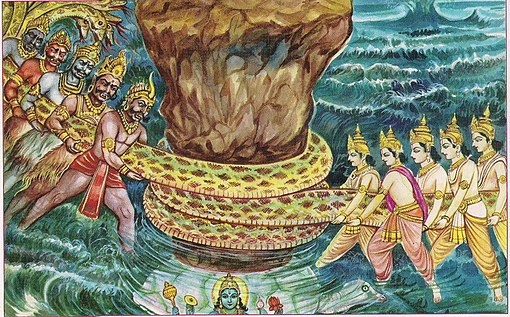The Story of Samudra Manthan
Samudra Manthan is a central episode in Hindu mythology, featured in various ancient texts including the Puranas. The story is an allegory for the cosmic churning of the ocean to extract valuable substances and illustrate the struggle between the gods (Devas) and demons (Asuras).
The Background
The Conflict: The gods and demons, once allies, become rivals. They are both vying for supremacy and immortality. To gain the nectar of immortality (amrita), they decide to churn the ocean of milk (Kshira Sagara) to obtain it.
The Churning Process: To churn the ocean, Mount Mandara is used as the churning rod, and the serpent Vasuki serves as the churning rope. The gods and demons take turns pulling the serpent to churn the ocean. This process creates a tumultuous upheaval, resulting in numerous precious items emerging from the ocean.
The Emergence of Rahu
During the churning process, several valuable items and beings emerge from the ocean:
The Nectar of Immortality (Amrita): The primary goal of the churning is to obtain this nectar, which grants immortality to those who consume it.
Laxmi: The goddess of wealth and prosperity.
Kamadhenu: The divine cow that grants all wishes.
Uchhaishravas: The celestial horse.
Parijat Tree: The divine tree with celestial flowers.
Swarbhanu’s Deception
Among these valuable items, the nectar of immortality is highly coveted. Swarbhanu, a demon, devises a plan to obtain the nectar by disguising himself as a deity. He positions himself between the Sun god (Surya) and the Moon god (Chandra), who are supervising the churning.
Disguised as a Deity: Swarbhanu successfully pretends to be a deity and partakes in the nectar.
Exposure and Punishment: The Sun and Moon gods expose Swarbhanu’s deceit to Lord Vishnu. To punish him, Vishnu beheads Swarbhanu with his discus (Sudarshana Chakra). However, by the time this happens, Swarbhanu has already consumed some of the nectar.
Transformation into Rahu and Ketu
Rahu: The head of Swarbhanu, after being severed, becomes Rahu. According to the myth, Rahu’s head is cursed to forever pursue the Sun and Moon in revenge. This pursuit is believed to be the cause of solar and lunar eclipses, as Rahu occasionally catches and swallows them.
Ketu: The body of Swarbhanu becomes Ketu. Ketu is often associated with the tail of the demon and represents the shadowy aspects of life.
Astrological and Symbolic Significance
In Vedic astrology:
Rahu is considered a shadow planet that represents materialism, illusion, and confusion. It is known for creating significant life changes and challenges, often bringing about unexpected events.
Ketu, the counterpart to Rahu, is associated with spiritual pursuits, detachment, and liberation. It represents the tail of the demon and has its own distinct astrological significance.
The Samudra Manthan story is not just a mythological tale but a rich allegory representing the dualities of life, the interplay of cosmic forces, and the eternal struggle for immortality and divine favor. Rahu’s role in this narrative highlights the complex relationship between celestial events and human destiny in Hindu thought.
Characteristic of Rahu
Rahu is not a physical planet but rather a shadowy, celestial entity in Vedic astrology. It is one of the nine major celestial bodies, or "Navagraha," in Hindu astrology. Rahu represents the north lunar node, which is the point where the Moon’s orbit intersects the ecliptic, the apparent path of the Sun through the sky.
Mythological Origins
In Hindu mythology, Rahu is associated with a fascinating story involving the demon Swarbhanu. According to the myth, during the churning of the ocean (Samudra Manthan) to obtain the nectar of immortality (amrita), Swarbhanu disguised himself as a deity to partake in the nectar. However, he was discovered by the Sun and Moon gods. As a result, Lord Vishnu decapitated him. The head of Swarbhanu became Rahu, and his body became Ketu.
Rahu: The head of the demon, which continues to chase the Sun and Moon out of revenge.
Ketu: The body of the demon, which represents the tail.
In the myth, Rahu's decapitated head was cursed to wander through the heavens and periodically swallow the Sun or the Moon, causing eclipses.
Astrological Significance
In Vedic astrology, Rahu is known as a shadow planet and is associated with various qualities:
Rahu is considered a malefic planet, often linked to confusion, illusions, and materialistic desires.
It influences a person’s life by creating unexpected events and experiences, often associated with sudden changes or upheavals.
It is known for its role in bringing transformations and challenges, but also opportunities for growth and change.
Rahu's placement in an astrological chart is analyzed for its impact on a person’s career, health, and personal life.
Cultural and Spiritual Impact
Rahu is a significant figure in Hindu astrology, influencing rituals and practices. Many astrologers and devotees perform specific remedies or rituals to mitigate the challenging effects of Rahu in their charts.
In addition to its astrological importance, Rahu is featured in various religious and cultural contexts, reflecting the deep integration of celestial events into ancient Hindu beliefs and practices.


